When Time magazine chose Banksy, a British artist-filmmaker, activist, all-purpose provocateur, painter, and graffiti master—to feature in their list of the top 100 most influential individuals globally, Banksy found himself in the company of Lady Gaga, Steve Jobs, and Barack Obama.
He gave the magazine a picture of his head wrapped in a recyclable paper bag. Many of his fans don’t want to know the man behind the mask and have protested attempts by the media to unmask him.
However, the fans are interested in following his upward trajectory from the pariah spraying—or, as slang puts it, “bombing”—walls in England in the 1990s to the artist whose pieces command huge amounts of cash in American and British auction houses.

Banksy has bombed several cities worldwide, including San Francisco, Detroit, Paris, and Vienna. He has moved from spraying graffiti on grainy urban walls to film, conceptual sculpture, and painting on canvas. His film, The guileful documentary Exit Through the Gift Shop, got a nomination for the Academy Awards.
The artist set up two organisations, the tongue-in-cheek and Pest Control, to authenticate his real work and to safeguard him from prying eyes. Hiding behind email and paper bags, he continuously controls his narrative. The last face-to-face interview he did was in 2013.
Even though he hides behind his unknown identity, Banksy advocates for a direct link between an artist and his audience. According to Banksy, there’s an entire fan base out there, and selling one’s art has never been easier.
Banksy maintains that one doesn’t have to go to college, carry around a portfolio, send transparencies to snobbish galleries, or compromise your moral values; all you require is several excellent concepts and an internet connection. He further reiterates that for the first time, the bourgeois art world belongs to people; therefore, artists need to make it count.
Banky’s Debut
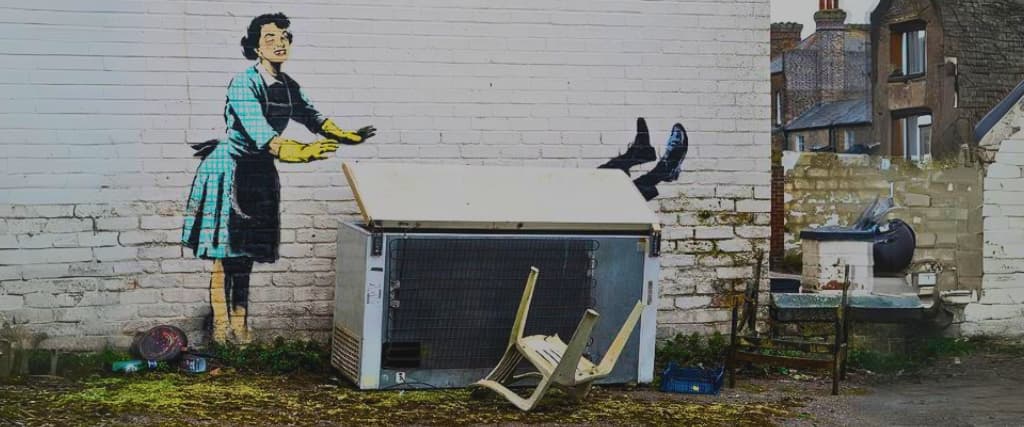
In the 1980s, Bristol’s Barton Hill district was a scary part of town. The town was predominantly white, with only less than three black families. The town was filled with run-down, working-class families that weren’t welcoming to strangers.
Therefore, when Banksy, who came from a more affluent area, decided to debut in Barton Hill, he was apprehensive. His dada had been beaten to a pulp while growing up in the area. Initially, Banksy used to sign off his art as Robin Banx. With time, it evolved into Banksy. The name Banksy gave less of a gangster vibe than the “robbing banks.” Nevertheless, it was easier to inscribe on a wall and more memorable.

Around the same time, Banksy settled on his unique stencil approach to graffiti. Once, when he was 18, he was painting a train with a group of friends when the police appeared, and everyone bolted. All his friends made it to the vehicle and disappeared. At this moment, the artist realised he had to cut his painting time by half or stop painting altogether.
He spent more than one hour hiding below a dumper truck with oil leaking all over him. As he was staring at the stencil plate on the fuel tank, he came up with the brilliant idea of copying the style and making every letter three feet high.
However, once he cut his first stencil, he felt the power there. Banksy likes the political angle, and graffiti is a form of dissent. Nevertheless, stencils have more history as they’ve been used to stop wars and start revolutions.
The Peculiar Primitive Feel
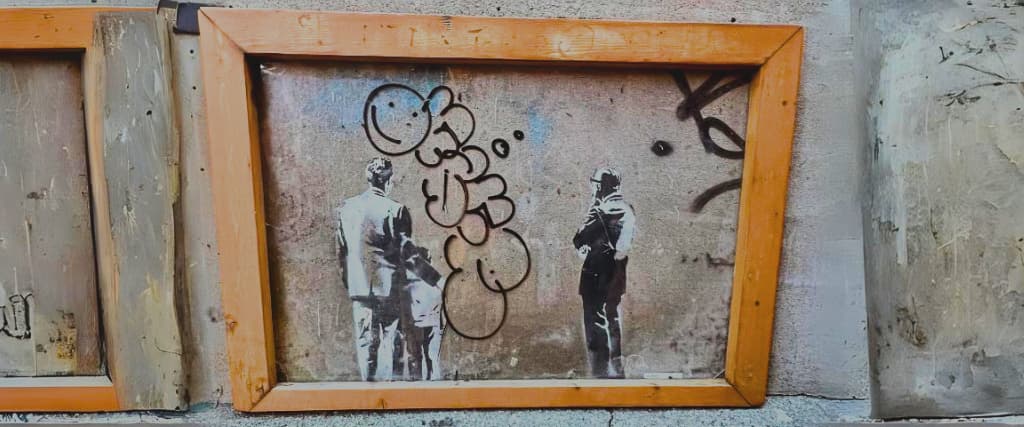
In the early days, while he drew people and animals, he’d experience an odd primitive feel of them. Banksy’s favourite work welcomes you when you go to Bristol’s Pierced Up tattoo parlour.
The parlour’s walls have paintings depicting giant wasps( with tv sets added on as extra weapons) and beautiful dive-bombing flowers in a vase. Maryanne Kemp, the parlour manager, describes the artist’s marathon painting session as an all-nighter.
In 1999, Banksy packed his bags and headed to London. As he travelled to the new city, he was also retreating to anonymity. The artist has issues with the police, so he evaded them. However, he’d soon learn that anonymity created its invaluable buzz.

People started comparing his work to Keith Haring and Jean-Michel Basquiat once his art appeared in cities across the country.
In 2001, Banksy had his first exhibition in London in Rivington. Banksy and his friends convened in a tunnel close to a club and hung some decorators’ signs they had removed from a construction site.
They painted the walls white and hoisted the work in less than 25 minutes. Later that week, they held an opening party with beer and hip-hop playing in the background in a transit van. Roughly 500 people showed up to the event, which cost almost nothing.
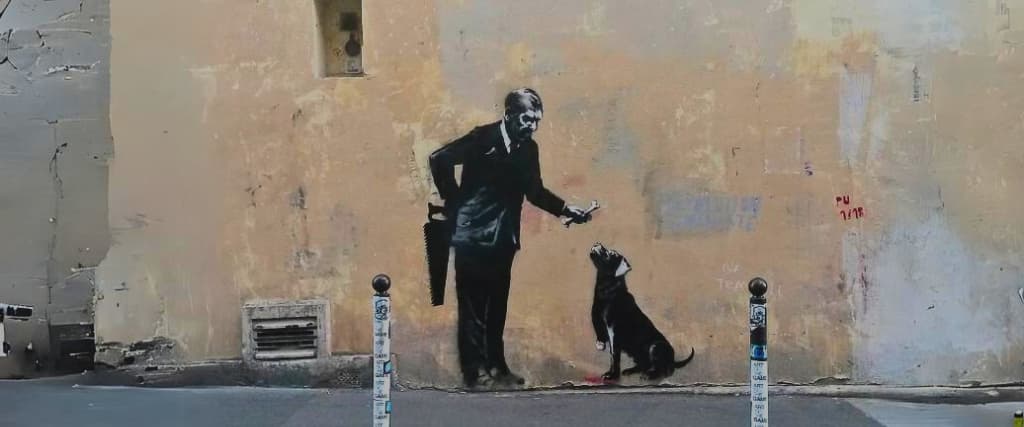
Banksy launched his breakthrough exhibition, Turf War, in 2003. The exhibit was staged in a warehouse in Hackney. It featured a live heifer and a carnival atmosphere.
Late in 2003, a cloaked figure in a dark coat, floppy hat, and scarf entered Tate Britain holding a huge paper bag. The artificial his way to room 7 on the second floor and dug out his picture and an unsigned painting of rural England which he had collected in a street market in London.
The piece was titled Crimewatch UK, and the man had stencilled a police crime scene tape. The cloaked man’s display ruined the countryside scenery for Banksy And his friends.
From Making Prankster Art To Shows In Big Museums
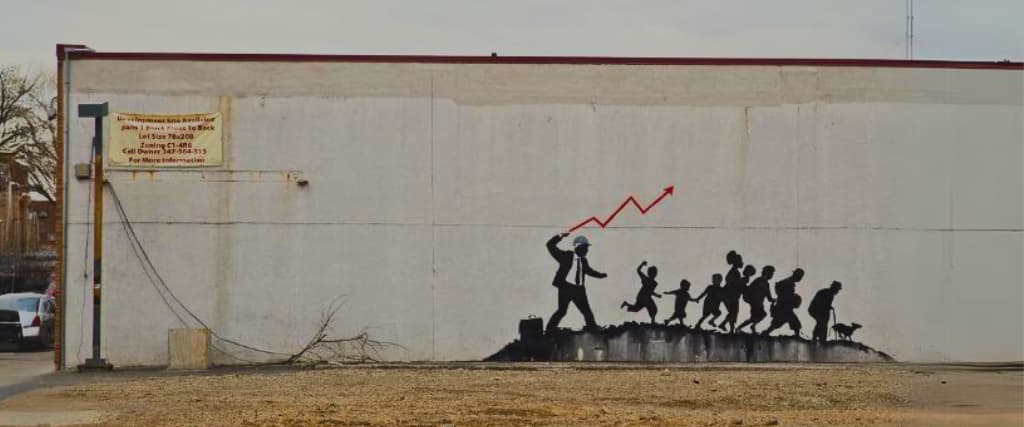
In the subsequent 17 months, Banksy, while in disguise, delivered his prankster performance art to leading museums like Lovre. In the Louvre, he installed a painting of the Mona Lisa with a smiley-face sticker.
In New York, he attached a tiny painting of a woman (which he found and altered to depict the woman adorning a gas mask) to a wall in the Metropolitan Museum of Art. Following this, the museum’s spokeswoman stated that getting a piece inside the met would take more effort.
Banksy gained international recognition for his art in 2005 when he arrived in Israel and painted various images on the West Bank’s wall. This wall is a segment of the barrier to prevent suicide bombers.
The paintings’ theme was escaping, and they featured pictures of a woman holding balloons as she’s taken on top of a wall, a boy with a ladder placed against the wall, and two children with a spade and bucket dreaming of a beach.
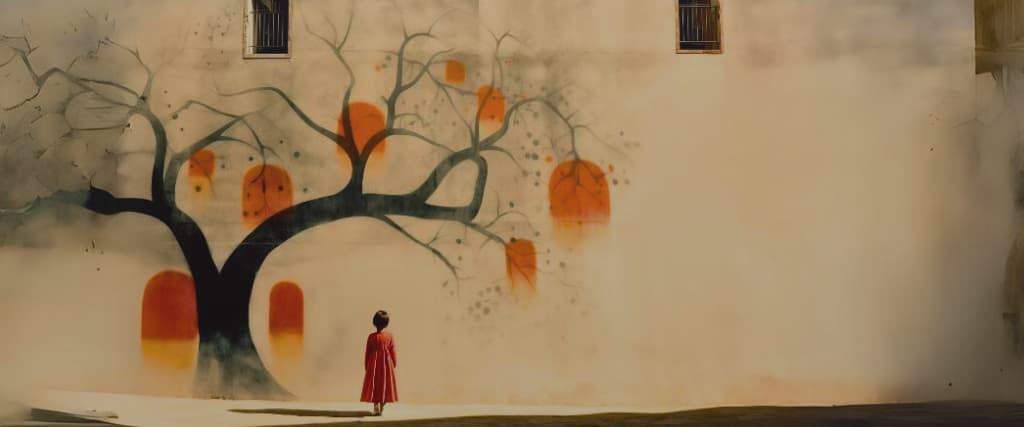
Two months after his trip to Israel, Banksy had a London exhibition where he took his Prankster Performance art to new levels. He reworked Claude Monet’s Water Lilies painting to include shopping carts and trash floating beside the lily pods.
He also redid Edward Hopper’s Hawks painting to include a vandal smashing the window featured in the painting. He included his signature touch by littering the gallery with 164 live rats, testing his critics’ patience levels.
Banksy’s entry into the Los Angeles art scene was almost inevitable. The artist described Los Angeles as a town where they honour their stars by inscribing their names on pavements to be walked on by people and peed on dogs.
Los Angeles seemed like the ideal place to become ambitious. His show pulled in over 30,000 people and stars like Brad Pit. In an interview with LA Times, the actor wistfully noted that Banksy did all those amazing shows, and he was still able to remain anonymous.
The Artist’s Most Famous Pieces
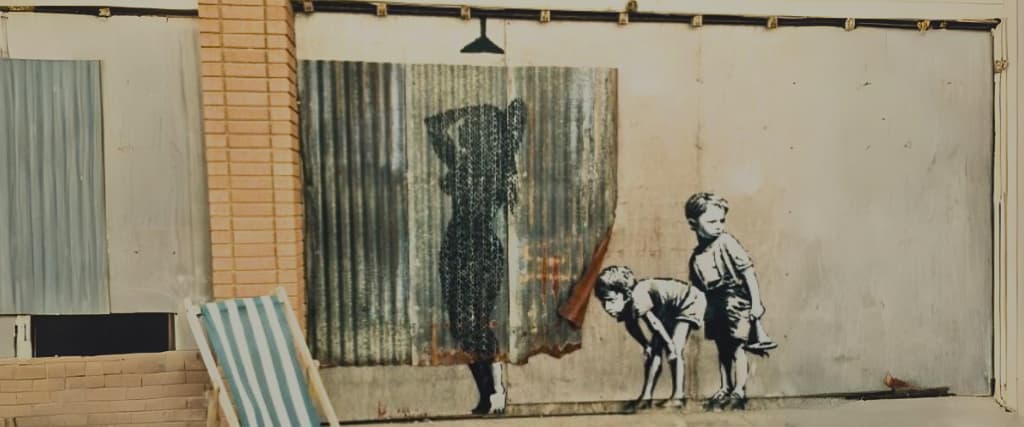
The exhibition centrepiece show featured an 8000-pound elephant (live) covered in red paint and smeared with a heraldic pattern. Los Angeles outspoken animal rights activists were enraged; the authorities called for the paint to be washed off. The crowd was supplied with fliers that pointed to the elephant in the room; more than 20 billion people live in poverty.
Seven months after the Lehman Brothers collapse, New York’s elite gathered at Sotheby’s for a night of merry-making. Artist Damien Hirst organised this event, the biggest charity auction in history, and raised $42.5 million to support African health programs.
The artist also reworked Landscape, a painting featuring a pastoral; scene, inscribed it with “this isn’t a photo opportunity.” The painting went for $385000. Another painting he did featuring an actual British telephone booth bent 90° with red paint where a pickax had perforated it went for $605000. The buyer was later revealed to be Mark Getty, J. Paul Getty’s grandson.
The artist took on the film industry with his film Exit Through the Gift Shop. The New York Times described the film as paralleling the artist’s best work. The film was nominated for an Oscar in 2010.
The Extensive Showcasing Of Street Art

In 2011, the Los Angeles Museum of Contemporary Art conducted a comprehensive graffiti and street art survey. The exhibit demonstrated what is now known as the “Banksy Effect.” The phenomenon describes how the artist successfully brought urban, newcomer art into the cultural and increasingly lucrative mainstream art scene.
One can argue that the artist’s subversiveness has diminished as prices continue to rise. He might well have reached the peak of his career, where due to his success, he can’t be rooted in the culture he rose from.
In 2011, riots broke out in the Stokes Croft region in Bristol as people protested against opening a Tesco supermarket. Police raided the protestors after receiving a tip that the group intended to make a petrol bomb.
Banksy volunteered to create a £5 souvenir piece that consisted of a Tesco Vale Petrol bomb. The proceeds of this art would go to a neighbourhood revival group called The People’s Republic of Stokes Croft. His generosity wasn’t met with open arms; some critics denounced him as a champagne socialist.
Banksy has countered this sought of attack repeatedly. For example, he told the New Yorker via email that he gives away many paintings for free and doesn’t think one can make art about global poverty and pocket the cash.
He notes the irony of how his nonconformist art attracts huge prices. In an interview, he stated that he loved how capitalism always finds a place on the table—even for anticapitalists.
Bottom Line
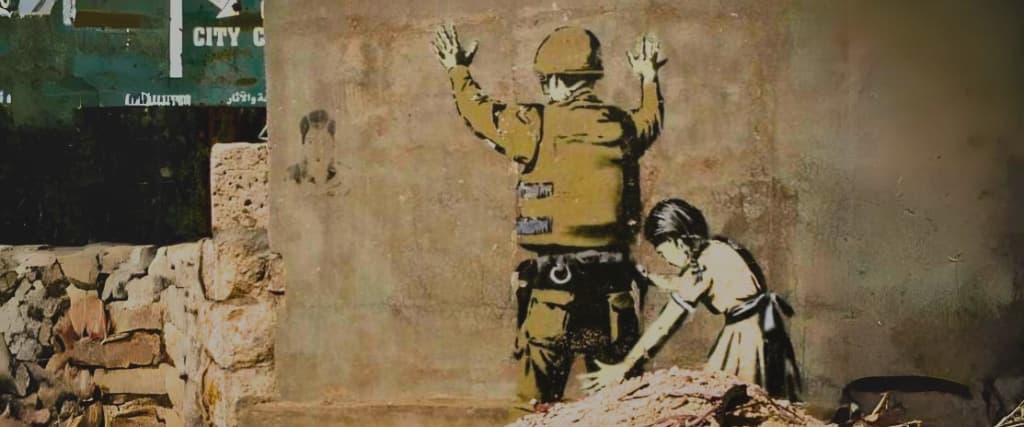
While Banksy’s art piece prices continue to grow, there’s some poignancy surrounding his work. Some of his best works only exist in photographs or memory. If you walk the streets of London trying to locate Banksy’s work, you’ll be disappointed to learn that some have disappeared altogether, others destroyed, and some whitewashed.
The latest chapter in the artist’s saga has some mysteries. During the London Olympics, Banksy posted two Olympic-themed pieces online. They featured a javelin thrower and pole vaulter flying over a barbed-wire fence. The twist is that the location of these pieces remains unknown. Somewhere in the streets of London, a pair of the artist’s latest works lies undiscovered.
